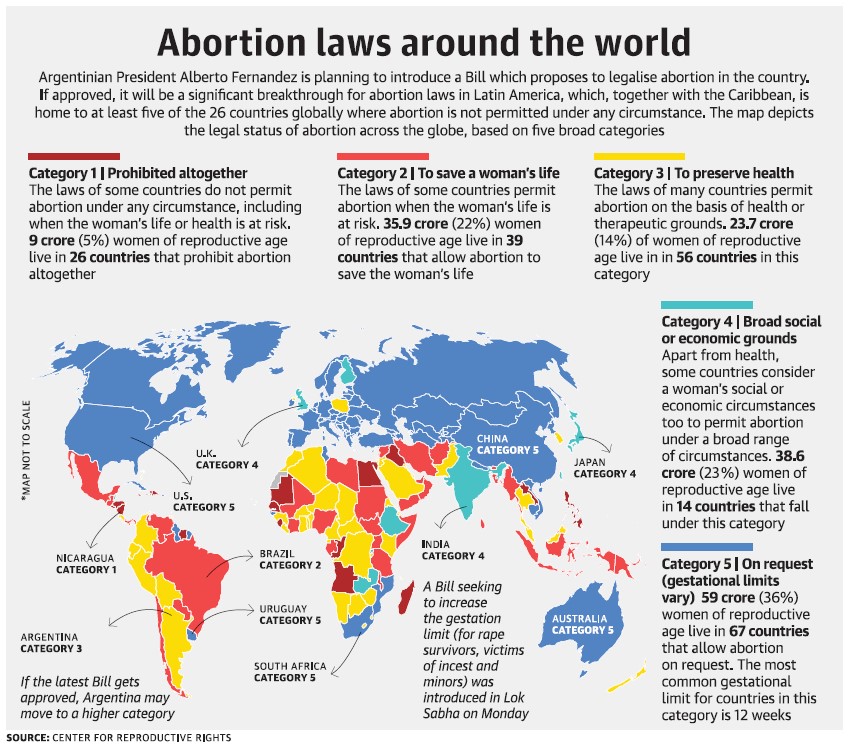Focus: GS-II Social Justice, Governance, Prelims
Why in news?
- The Lok Sabha on 17th March 2020, passed a Bill to extend the upper limit for permitting abortions from 20 weeks to 24 under special circumstances.
- The “special categories of women” include rape survivors, victims of incest, the differently abled and minors, Health Minister said moving the Bill.
- The Medical Termination of Pregnancy (Amendment) Bill, 2020, which seeks to amend the MTP Act, 1971, was passed by a voice vote.
Background on Abortion in India
- Abortion in India is legal in certain circumstances. It can be performed on various grounds until 24 weeks of pregnancy. In exceptional cases, a court may allow a termination after 24 weeks.
- When a woman gets a pregnancy terminated voluntarily from a service provider, it is called induced abortion. Spontaneous abortion is when the process of abortion starts on its own without any intervention. In common language, this is also known as miscarriage.
- Before 1971, abortion was criminalized under Section 312 of the Indian Penal Code, 1860, describing it as intentionally ‘causing miscarriage’.
- It was in the 1960s, when abortion was legal in 15 countries, that deliberations on a legal framework for induced abortion in India was initiated.
- The alarmingly increased number of abortions taking place put the Ministry of Health and Family Welfare (MoHFW) on alert.
- To address this, the Government of India instated a Committee in 1964 led by Shantilal Shah to come up with suggestions to draft the abortion law for India.
- The recommendations of this Committee were accepted in 1970 and introduced in the Parliament as the Medical Termination of Pregnancy Bill.
The Medical Termination of Pregnancy Act, 1971
The Medical Termination of Pregnancy (MTP) Act, 1971 provides the legal framework for making CAC services available in India.
Termination of pregnancy is permitted for a broad range of conditions up to 20 weeks of gestation as detailed below:
- When continuation of pregnancy is a risk to the life of a pregnant woman or could cause grave injury to her physical or mental health;
- When there is substantial risk that the child, if born, would be seriously handicapped due to physical or mental abnormalities;
- When pregnancy is caused due to rape (presumed to cause grave injury to the mental health of the woman);
- When pregnancy is caused due to failure of contraceptives used by a married woman or her husband (presumed to constitute grave injury to mental health of the woman).
The MTP Act specifies –
- who can terminate a pregnancy;
- till when a pregnancy can be terminated; and
- where can a pregnancy be terminated.

Medical Termination of Pregnancy (Amendment) Bill, 2020
It is an Amendment to the Medical Termination of Pregnancy (MTP) Act, 1971.
Proposals of the Bill:
- The requirement of the opinion of one registered medical practitioner (instead of two or more) for termination of pregnancy up to 20 weeks of gestation (foetal development period from the time of conception until birth).
- Introduce the requirement of the opinion of two registered medical practitioners for termination of pregnancy of 20-24 weeks of gestation.
- Increase the gestation limit for ‘special categories’ of women which includes survivors of rape, victims of incest and other vulnerable women like differently-abled women and minors.
- The “name and other particulars of a woman whose pregnancy has been terminated shall not be revealed”, except to a person authorised in any law that is currently in force.
Voice Vote
- A voice vote is used in Lok Sabha, Rajya Sabha and state assemblies to vote for certain resolutions.
- It is used when there is a wide agreement on issues and in some cases where the house is not in order.
- The presiding officer or chair of the assembly will put the question to the assembly, asking first for all those in favor of the motion to indicate so orally (“aye” or “yes”), and then ask second all those opposed to the motion to indicate so verbally (“nay” or “no”).
- The chair will then make an estimate of the count on each side and state what they believe the result to be.




